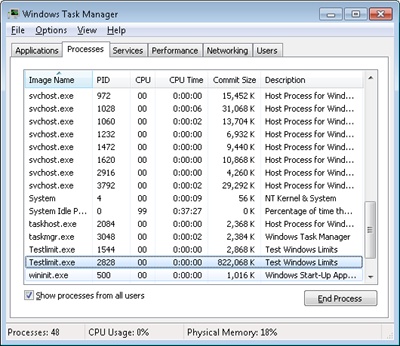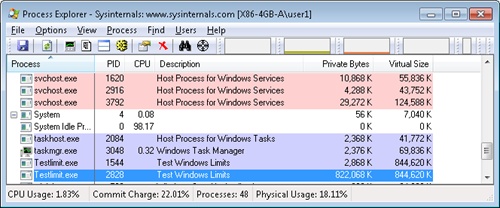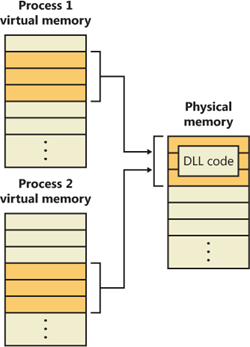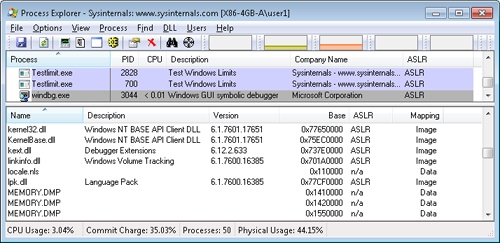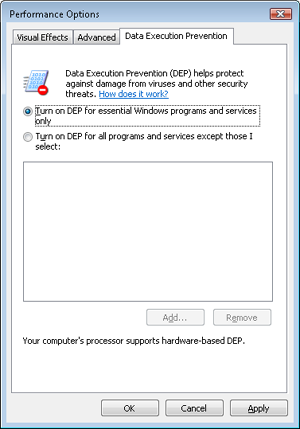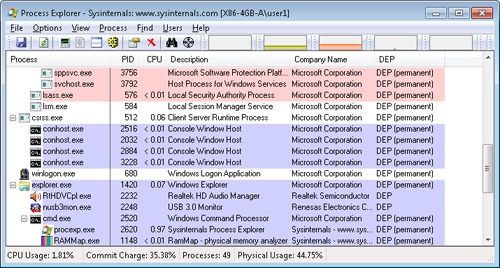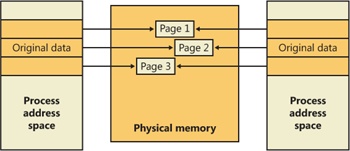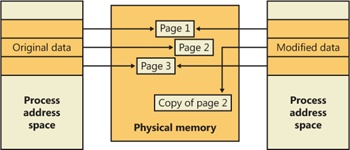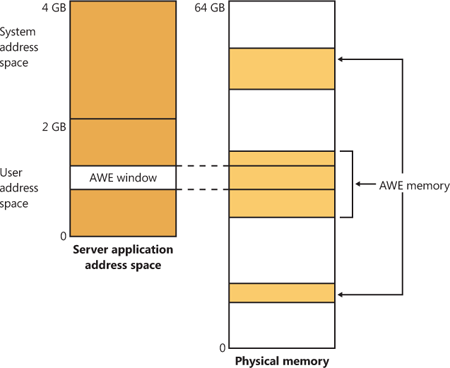The memory manager provides a set of system services to allocate and free virtual memory, share memory between processes, map files into memory, flush virtual pages to disk, retrieve information about a range of virtual pages, change the protection of virtual pages, and lock the virtual pages into memory.
Like other Windows executive services, the memory management services allow their caller to supply a process handle indicating the particular process whose virtual memory is to be manipulated. The caller can thus manipulate either its own memory or (with the proper permissions) the memory of another process. For example, if a process creates a child process, by default it has the right to manipulate the child process’s virtual memory. Thereafter, the parent process can allocate, deallocate, read, and write memory on behalf of the child process by calling virtual memory services and passing a handle to the child process as an argument. This feature is used by subsystems to manage the memory of their client processes. It is also essential for implementing debuggers because debuggers must be able to read and write to the memory of the process being debugged.
Most of these services are exposed through the Windows API. The Windows API has three groups of functions for managing memory in applications: heap functions (Heapxxx and the older interfaces Localxxx and Globalxxx, which internally make use of the Heapxxx APIs), which may be used for allocations smaller than a page; virtual memory functions, which operate with page granularity (Virtualxxx); and memory mapped file functions (CreateFileMapping, CreateFileMappingNuma, MapViewOfFile, MapViewOfFileEx, and MapViewOfFileExNuma). (We’ll describe the heap manager later in this chapter.)
The memory manager also provides a number of services (such as allocating and deallocating physical memory and locking pages in physical memory for direct memory access [DMA] transfers) to other kernel-mode components inside the executive as well as to device drivers. These functions begin with the prefix Mm. In addition, though not strictly part of the memory manager, some executive support routines that begin with Ex are used to allocate and deallocate from the system heaps (paged and nonpaged pool) as well as to manipulate look-aside lists. We’ll touch on these topics later in this chapter in the section Kernel-Mode Heaps (System Memory Pools)).
The virtual address space is divided into units called pages. That is because the hardware memory management unit translates virtual to physical addresses at the granularity of a page. Hence, a page is the smallest unit of protection at the hardware level. (The various page protection options are described in the section Protecting Memory later in the chapter.) The processors on which Windows runs support two page sizes, called small and large. The actual sizes vary based on the processor architecture, and they are listed in Table 10-1.
Note
IA64 processors support a variety of dynamically configurable page sizes, from 4 KB up to 256 MB. Windows on Itanium uses 8 KB and 16 MB for small and large pages, respectively, as a result of performance tests that confirmed these values as optimal. Additionally, recent x64 processors support a size of 1 GB for large pages, but Windows does not use this feature.
The primary advantage of large pages is speed of address translation for references to other data within the large page. This advantage exists because the first reference to any byte within a large page will cause the hardware’s translation look-aside buffer (TLB, described in a later section) to have in its cache the information necessary to translate references to any other byte within the large page. If small pages are used, more TLB entries are needed for the same range of virtual addresses, thus increasing recycling of entries as new virtual addresses require translation. This, in turn, means having to go back to the page table structures when references are made to virtual addresses outside the scope of a small page whose translation has been cached. The TLB is a very small cache, and thus large pages make better use of this limited resource.
To take advantage of large pages on systems with more than 2 GB of RAM, Windows maps with large pages the core operating system images (Ntoskrnl.exe and Hal.dll) as well as core operating system data (such as the initial part of nonpaged pool and the data structures that describe the state of each physical memory page). Windows also automatically maps I/O space requests (calls by device drivers to MmMapIoSpace) with large pages if the request is of satisfactory large page length and alignment. In addition, Windows allows applications to map their images, private memory, and page-file-backed sections with large pages. (See the MEM_LARGE_PAGE flag on the VirtualAlloc, VirtualAllocEx, and VirtualAllocExNuma functions.) You can also specify other device drivers to be mapped with large pages by adding a multistring registry value to HKLM\SYSTEM\CurrentControlSet\Control\Session Manager\Memory Management\LargePageDrivers and specifying the names of the drivers as separately null-terminated strings.
Attempts to allocate large pages may fail after the operating system has been running for an extended period, because the physical memory for each large page must occupy a significant number (see Table 10-1) of physically contiguous small pages, and this extent of physical pages must furthermore begin on a large page boundary. (For example, physical pages 0 through 511 could be used as a large page on an x64 system, as could physical pages 512 through 1,023, but pages 10 through 521 could not.) Free physical memory does become fragmented as the system runs. This is not a problem for allocations using small pages but can cause large page allocations to fail.
It is not possible to specify anything but read/write access to large pages. The memory is also always nonpageable, because the page file system does not support large pages. And, because the memory is nonpageable, it is not considered part of the process working set (described later). Nor are large page allocations subject to job-wide limits on virtual memory usage.
There is an unfortunate side effect of large pages. Each page (whether large or small) must be mapped with a single protection that applies to the entire page (because hardware memory protection is on a per-page basis). If a large page contains, for example, both read-only code and read/write data, the page must be marked as read/write, which means that the code will be writable. This means that device drivers or other kernel-mode code could, as a result of a bug, modify what is supposed to be read-only operating system or driver code without causing a memory access violation. If small pages are used to map the operating system’s kernel-mode code, the read-only portions of Ntoskrnl.exe and Hal.dll can be mapped as read-only pages. Using small pages does reduce efficiency of address translation, but if a device driver (or other kernel-mode code) attempts to modify a read-only part of the operating system, the system will crash immediately with the exception information pointing at the offending instruction in the driver. If the write was allowed to occur, the system would likely crash later (in a harder-to-diagnose way) when some other component tried to use the corrupted data.
If you suspect you are experiencing kernel code corruptions, enable Driver Verifier (described later in this chapter), which will disable the use of large pages.
Pages in a process virtual address space are free, reserved, committed, or shareable. Committed and shareable pages are pages that, when accessed, ultimately translate to valid pages in physical memory.
Committed pages are also referred to as private pages. This reflects the fact that committed pages cannot be shared with other processes, whereas shareable pages can be (but, of course, might be in use by only one process).
Private pages are allocated through the Windows VirtualAlloc, VirtualAllocEx, and VirtualAllocExNuma functions. These functions allow a thread to reserve address space and then commit portions of the reserved space. The intermediate “reserved” state allows the thread to set aside a range of contiguous virtual addresses for possible future use (such as an array), while consuming negligible system resources, and then commit portions of the reserved space as needed as the application runs. Or, if the size requirements are known in advance, a thread can reserve and commit in the same function call. In either case, the resulting committed pages can then be accessed by the thread. Attempting to access free or reserved memory results in an exception because the page isn’t mapped to any storage that can resolve the reference.
If committed (private) pages have never been accessed before, they are created at the time of first access as zero-initialized pages (or demand zero). Private committed pages may later be automatically written to the paging file by the operating system if required by demand for physical memory. “Private” refers to the fact that these pages are normally inaccessible to any other process.
Note
There are functions, such as ReadProcessMemory and WriteProcessMemory, that apparently permit cross-process memory access, but these are implemented by running kernel-mode code in the context of the target process (this is referred to as attaching to the process). They also require that either the security descriptor of the target process grant the accessor the PROCESS_VM_READ or PROCESS_VM_WRITE right, respectively, or that the accessor holds SeDebugPrivilege, which is by default granted only to members of the Administrators group.
Shared pages are usually mapped to a view of a section, which in turn is part or all of a file, but may instead represent a portion of page file space. All shared pages can potentially be shared with other processes. Sections are exposed in the Windows API as file mapping objects.
When a shared page is first accessed by any process, it will be read in from the associated mapped file (unless the section is associated with the paging file, in which case it is created as a zero-initialized page). Later, if it is still resident in physical memory, the second and subsequent processes accessing it can simply use the same page contents that are already in memory. Shared pages might also have been prefetched by the system.
Two upcoming sections of this chapter, Shared Memory and Mapped Files and Section Objects, go into much more detail about shared pages. Pages are written to disk through a mechanism called modified page writing. This occurs as pages are moved from a process’s working set to a systemwide list called the modified page list; from there, they are written to disk (or remote storage). (Working sets and the modified list are explained later in this chapter.) Mapped file pages can also be written back to their original files on disk as a result of an explicit call to FlushViewOfFile or by the mapped page writer as memory demands dictate.
You can decommit private pages and/or release address space with the VirtualFree or VirtualFreeEx function. The difference between decommittal and release is similar to the difference between reservation and committal—decommitted memory is still reserved, but released memory has been freed; it is neither committed nor reserved.
Using the two-step process of reserving and then committing virtual memory defers committing pages—and, thereby, defers adding to the system “commit charge” described in the next section—until needed, but keeps the convenience of virtual contiguity. Reserving memory is a relatively inexpensive operation because it consumes very little actual memory. All that needs to be updated or constructed is the relatively small internal data structures that represent the state of the process address space. (We’ll explain these data structures, called page tables and virtual address descriptors, or VADs, later in the chapter.)
One extremely common use for reserving a large space and committing portions of it as needed is the user-mode stack for each thread. When a thread is created, a stack is created by reserving a contiguous portion of the process address space. (1 MB is the default; you can override this size with the CreateThread and CreateRemoteThread function calls or change it on an imagewide basis by using the /STACK linker flag.) By default, the initial page in the stack is committed and the next page is marked as a guard page (which isn’t committed) that traps references beyond the end of the committed portion of the stack and expands it.
On Task Manager’s Performance tab, there are two numbers following the legend Commit. The memory manager keeps track of private committed memory usage on a global basis, termed commitment or commit charge; this is the first of the two numbers, which represents the total of all committed virtual memory in the system.
There is a systemwide limit, called the system commit limit or simply the commit limit, on the amount of committed virtual memory that can exist at any one time. This limit corresponds to the current total size of all paging files, plus the amount of RAM that is usable by the operating system. This is the second of the two numbers displayed as Commit on Task Manager’s Performance tab. The memory manager can increase the commit limit automatically by expanding one or more of the paging files, if they are not already at their configured maximum size.
Commit charge and the system commit limit will be explained in more detail in a later section.
In general, it’s better to let the memory manager decide which pages remain in physical memory. However, there might be special circumstances where it might be necessary for an application or device driver to lock pages in physical memory. Pages can be locked in memory in two ways:
Windows applications can call the VirtualLock function to lock pages in their process working set. Pages locked using this mechanism remain in memory until explicitly unlocked or until the process that locked them terminates. The number of pages a process can lock can’t exceed its minimum working set size minus eight pages. Therefore, if a process needs to lock more pages, it can increase its working set minimum with the SetProcessWorkingSetSizeEx function (referred to in the section Working Set Management).
Device drivers can call the kernel-mode functions MmProbeAndLockPages, MmLockPagableCodeSection, MmLockPagableDataSection, or MmLockPagableSectionByHandle. Pages locked using this mechanism remain in memory until explicitly unlocked. The last three of these APIs enforce no quota on the number of pages that can be locked in memory because the resident available page charge is obtained when the driver first loads; this ensures that it can never cause a system crash due to overlocking. For the first API, quota charges must be obtained or the API will return a failure status.
Windows aligns each region of reserved process address space to begin on an integral boundary defined by the value of the system allocation granularity, which can be retrieved from the Windows GetSystemInfo or GetNativeSystemInfo function. This value is 64 KB, a granularity that is used by the memory manager to efficiently allocate metadata (for example, VADs, bitmaps, and so on) to support various process operations. In addition, if support were added for future processors with larger page sizes (for example, up to 64 KB) or virtually indexed caches that require systemwide physical-to-virtual page alignment, the risk of requiring changes to applications that made assumptions about allocation alignment would be reduced.
Note
Windows kernel-mode code isn’t subject to the same restrictions; it can reserve memory on a single-page granularity (although this is not exposed to device drivers for the reasons detailed earlier). This level of granularity is primarily used to pack TEB allocations more densely, and because this mechanism is internal only, this code can easily be changed if a future platform requires different values. Also, for the purposes of supporting 16-bit and MS-DOS applications on x86 systems only, the memory manager provides the MEM_DOS_LIM flag to the MapViewOfFileEx API, which is used to force the use of single-page granularity.
Finally, when a region of address space is reserved, Windows ensures that the size and base of the region is a multiple of the system page size, whatever that might be. For example, because x86 systems use 4-KB pages, if you tried to reserve a region of memory 18 KB in size, the actual amount reserved on an x86 system would be 20 KB. If you specified a base address of 3 KB for an 18-KB region, the actual amount reserved would be 24 KB. Note that the VAD for the allocation would then also be rounded to 64-KB alignment/length, thus making the remainder of it inaccessible. (VADs will be described later in this chapter.)
As is true with most modern operating systems, Windows provides a mechanism to share memory among processes and the operating system. Shared memory can be defined as memory that is visible to more than one process or that is present in more than one process virtual address space. For example, if two processes use the same DLL, it would make sense to load the referenced code pages for that DLL into physical memory only once and share those pages between all processes that map the DLL, as illustrated in Figure 10-1.
Each process would still maintain its private memory areas in which to store private data, but the DLL code and unmodified data pages could be shared without harm. As we’ll explain later, this kind of sharing happens automatically because the code pages in executable images (.exe and .dll files, and several other types like screen savers (.scr), which are essentially DLLs under other names) are mapped as execute-only and writable pages are mapped as copy-on-write. (See the section Copy-on-Write for more information.)
The underlying primitives in the memory manager used to implement shared memory are called section objects, which are exposed as file mapping objects in the Windows API. The internal structure and implementation of section objects are described in the section Section Objects later in this chapter.
This fundamental primitive in the memory manager is used to map virtual addresses, whether in main memory, in the page file, or in some other file that an application wants to access as if it were in memory. A section can be opened by one process or by many; in other words, section objects don’t necessarily equate to shared memory.
A section object can be connected to an open file on disk (called a mapped file) or to committed memory (to provide shared memory). Sections mapped to committed memory are called page-file-backed sections because the pages are written to the paging file (as opposed to a mapped file) if demands on physical memory require it. (Because Windows can run with no paging file, page-file-backed sections might in fact be “backed” only by physical memory.) As with any other empty page that is made visible to user mode (such as private committed pages), shared committed pages are always zero-filled when they are first accessed to ensure that no sensitive data is ever leaked.
To create a section object, call the Windows CreateFileMapping or CreateFileMappingNuma function, specifying the file handle to map it to (or INVALID_HANDLE_VALUE for a page-file-backed section) and optionally a name and security descriptor. If the section has a name, other processes can open it with OpenFileMapping. Or you can grant access to section objects through either handle inheritance (by specifying that the handle be inheritable when opening or creating the handle) or handle duplication (by using DuplicateHandle). Device drivers can also manipulate section objects with the ZwOpenSection, ZwMapViewOfSection, and ZwUnmapViewOfSection functions.
A section object can refer to files that are much larger than can fit in the address space of a process. (If the paging file backs a section object, sufficient space must exist in the paging file and/or RAM to contain it.) To access a very large section object, a process can map only the portion of the section object that it requires (called a view of the section) by calling the MapViewOfFile, MapViewOfFileEx, or MapViewOfFileExNuma function and then specifying the range to map. Mapping views permits processes to conserve address space because only the views of the section object needed at the time must be mapped into memory.
Windows applications can use mapped files to conveniently perform I/O to files by simply making them appear in their address space. User applications aren’t the only consumers of section objects: the image loader uses section objects to map executable images, DLLs, and device drivers into memory, and the cache manager uses them to access data in cached files. (For information on how the cache manager integrates with the memory manager, see Chapter 11.) The implementation of shared memory sections, both in terms of address translation and the internal data structures, is explained later in this chapter.
As explained in Chapter 1, “Concepts and Tools,” in Part 1, Windows provides memory protection so that no user process can inadvertently or deliberately corrupt the address space of another process or of the operating system. Windows provides this protection in four primary ways.
First, all systemwide data structures and memory pools used by kernel-mode system components can be accessed only while in kernel mode—user-mode threads can’t access these pages. If they attempt to do so, the hardware generates a fault, which in turn the memory manager reports to the thread as an access violation.
Second, each process has a separate, private address space, protected from being accessed by any thread belonging to another process. Even shared memory is not really an exception to this because each process accesses the shared regions using addresses that are part of its own virtual address space. The only exception is if another process has virtual memory read or write access to the process object (or holds SeDebugPrivilege) and thus can use the ReadProcessMemory or WriteProcessMemory function. Each time a thread references an address, the virtual memory hardware, in concert with the memory manager, intervenes and translates the virtual address into a physical one. By controlling how virtual addresses are translated, Windows can ensure that threads running in one process don’t inappropriately access a page belonging to another process.
Third, in addition to the implicit protection virtual-to-physical address translation offers, all processors supported by Windows provide some form of hardware-controlled memory protection (such as read/write, read-only, and so on); the exact details of such protection vary according to the processor. For example, code pages in the address space of a process are marked read-only and are thus protected from modification by user threads.
Table 10-2 lists the memory protection options defined in the Windows API. (See the VirtualProtect, VirtualProtectEx, VirtualQuery, and VirtualQueryEx functions.)
Table 10-2. Memory Protection Options Defined in the Windows API
Attribute | Description |
|---|---|
Any attempt to read from, write to, or execute code in this region causes an access violation. | |
PAGE_READONLY | Any attempt to write to (and on processors with no execute support, execute code in) memory causes an access violation, but reads are permitted. |
PAGE_READWRITE | The page is readable and writable but not executable. |
PAGE_EXECUTE | Any attempt to write to code in memory in this region causes an access violation, but execution (and read operations on all existing processors) is permitted. |
PAGE_EXECUTE_READ[a] | Any attempt to write to memory in this region causes an access violation, but executes and reads are permitted. |
PAGE_EXECUTE_READWRITE[b] | The page is readable, writable, and executable—any attempted access will succeed. |
PAGE_WRITECOPY | Any attempt to write to memory in this region causes the system to give the process a private copy of the page. On processors with no-execute support, attempts to execute code in memory in this region cause an access violation. |
Any attempt to write to memory in this region causes the system to give the process a private copy of the page. Reading and executing code in this region is permitted. (No copy is made in this case.) | |
Any attempt to read from or write to a guard page raises an EXCEPTION_GUARD_PAGE exception and turns off the guard page status. Guard pages thus act as a one-shot alarm. Note that this flag can be specified with any of the page protections listed in this table except PAGE_NOACCESS. | |
PAGE_NOCACHE | Uses physical memory that is not cached. This is not recommended for general usage. It is useful for device drivers—for example, mapping a video frame buffer with no caching. |
PAGE_WRITECOMBINE | Enables write-combined memory accesses. When enabled, the processor does not cache memory writes (possibly causing significantly more memory traffic than if memory writes were cached), but it does try to aggregate write requests to optimize performance. For example, if multiple writes are made to the same address, only the most recent write might occur. Separate writes to adjacent addresses may be similarly collapsed into a single large write. This is not typically used for general applications, but it is useful for device drivers—for example, mapping a video frame buffer as write combined. |
[a] No execute protection is supported on processors that have the necessary hardware support (for example, all x64 and IA64 processors) but not in older x86 processors. [b] No execute protection is supported on processors that have the necessary hardware support (for example, all x64 and IA64 processors) but not in older x86 processors. | |
And finally, shared memory section objects have standard Windows access control lists (ACLs) that are checked when processes attempt to open them, thus limiting access of shared memory to those processes with the proper rights. Access control also comes into play when a thread creates a section to contain a mapped file. To create the section, the thread must have at least read access to the underlying file object or the operation will fail.
Once a thread has successfully opened a handle to a section, its actions are still subject to the memory manager and the hardware-based page protections described earlier. A thread can change the page-level protection on virtual pages in a section if the change doesn’t violate the permissions in the ACL for that section object. For example, the memory manager allows a thread to change the pages of a read-only section to have copy-on-write access but not to have read/write access. The copy-on-write access is permitted because it has no effect on other processes sharing the data.
No execute page protection (also referred to as data execution prevention, or DEP) causes an attempt to transfer control to an instruction in a page marked as “no execute” to generate an access fault. This can prevent certain types of malware from exploiting bugs in the system through the execution of code placed in a data page such as the stack. DEP can also catch poorly written programs that don’t correctly set permissions on pages from which they intend to execute code. If an attempt is made in kernel mode to execute code in a page marked as no execute, the system will crash with the ATTEMPTED_EXECUTE_OF_NOEXECUTE_MEMORY bugcheck code. (See Chapter 14, for an explanation of these codes.) If this occurs in user mode, a STATUS_ACCESS_VIOLATION (0xc0000005) exception is delivered to the thread attempting the illegal reference. If a process allocates memory that needs to be executable, it must explicitly mark such pages by specifying the PAGE_EXECUTE, PAGE_EXECUTE_READ, PAGE_EXECUTE_READWRITE, or PAGE_EXECUTE_WRITECOPY flags on the page granularity memory allocation functions.
On 32-bit x86 systems that support DEP, bit 63 in the page table entry (PTE) is used to mark a page as nonexecutable. Therefore, the DEP feature is available only when the processor is running in Physical Address Extension (PAE) mode, without which page table entries are only 32 bits wide. (See the section Physical Address Extension (PAE) later in this chapter.) Thus, support for hardware DEP on 32-bit systems requires loading the PAE kernel (%SystemRoot%\System32\Ntkrnlpa.exe), even if that system does not require extended physical addressing (for example, physical addresses greater than 4 GB). The operating system loader automatically loads the PAE kernel on 32-bit systems that support hardware DEP. To force the non-PAE kernel to load on a system that supports hardware DEP, the BCD option nx must be set to AlwaysOff, and the pae option must be set to ForceDisable.
On 64-bit versions of Windows, execution protection is always applied to all 64-bit processes and device drivers and can be disabled only by setting the nx BCD option to AlwaysOff. Execution protection for 32-bit programs depends on system configuration settings, described shortly. On 64-bit Windows, execution protection is applied to thread stacks (both user and kernel mode), user-mode pages not specifically marked as executable, kernel paged pool, and kernel session pool (for a description of kernel memory pools, see the section Kernel-Mode Heaps (System Memory Pools). However, on 32-bit Windows, execution protection is applied only to thread stacks and user-mode pages, not to paged pool and session pool.
The application of execution protection for 32-bit processes depends on the value of the BCD nx option. The settings can be changed by going to the Data Execution Prevention tab under Computer, Properties, Advanced System Settings, Performance Settings. (See Figure 10-2.) When you configure no execute protection in the Performance Options dialog box, the BCD nx option is set to the appropriate value. Table 10-3 lists the variations of the values and how they correspond to the DEP settings tab. The registry lists 32-bit applications that are excluded from execution protection under the key HKLM\SOFTWARE\Microsoft\Windows NT\CurrentVersion\AppCompatFlags\Layers, with the value name being the full path of the executable and the data set to “DisableNXShowUI”.
On Windows client versions (both 64-bit and 32-bit) execution protection for 32-bit processes is configured by default to apply only to core Windows operating system executables (the nx BCD option is set to OptIn) so as not to break 32-bit applications that might rely on being able to execute code in pages not specifically marked as executable, such as self-extracting or packed applications. On Windows server systems, execution protection for 32-bit applications is configured by default to apply to all 32-bit programs (the nx BCD option is set to OptOut).
Note
To obtain a complete list of which programs are protected, install the Windows Application Compatibility Toolkit (downloadable from www.microsoft.com) and run the Compatibility Administrator Tool. Click System Database, Applications, and then Windows Components. The pane at the right shows the list of protected executables.
Table 10-3. BCD nx Values
Option on DEP Settings Tab | Meaning | |
|---|---|---|
Turn on DEP for essential Windows programs and services only | Enables DEP for core Windows system images. Enables 32-bit processes to dynamically configure DEP for their lifetime. | |
OptOut | Turn on DEP for all programs and services except those I select | Enables DEP for all executables except those specified. Enables 32-bit processes to dynamically configure DEP for their lifetime. Enables system compatibility fixes for DEP. |
AlwaysOn | Enables DEP for all components with no ability to exclude certain applications. Disables dynamic configuration for 32-bit processes, and disables system compatibility fixes. | |
No dialog box option for this setting | Disables DEP (not recommended). Disables dynamic configuration for 32-bit processes. |
Even if you force DEP to be enabled, there are still other methods through which applications can disable DEP for their own images. For example, regardless of the execution protection options that are enabled, the image loader (see Chapter 3 in Part 1 for more information about the image loader) will verify the signature of the executable against known copy-protection mechanisms (such as SafeDisc and SecuROM) and disable execution protection to provide compatibility with older copy-protected software such as computer games.
Additionally, to provide compatibility with older versions of the Active Template Library (ATL) framework (version 7.1 or earlier), the Windows kernel provides an ATL thunk emulation environment. This environment detects ATL thunk code sequences that have caused the DEP exception and emulates the expected operation. Application developers can request that ATL thunk emulation not be applied by using the latest Microsoft C++ compiler and specifying the /NXCOMPAT flag (which sets the IMAGE_DLLCHARACTERISTICS_NX_COMPAT flag in the PE header), which tells the system that the executable fully supports DEP. Note that ATL thunk emulation is permanently disabled if the AlwaysOn value is set.
Finally, if the system is in OptIn or OptOut mode and executing a 32-bit process, the SetProcessDEPPolicy function allows a process to dynamically disable DEP or to permanently enable it. (Once enabled through this API, DEP cannot be disabled programmatically for the lifetime of the process.) This function can also be used to dynamically disable ATL thunk emulation in case the image wasn’t compiled with the /NXCOMPAT flag. On 64-bit processes or systems booted with AlwaysOff or AlwaysOn, the function always returns a failure. The GetProcessDEPPolicy function returns the 32-bit per-process DEP policy (it fails on 64-bit systems, where the policy is always the same—enabled), while GetSystemDEPPolicy can be used to return a value corresponding to the policies in Table 10-3.
For older processors that do not support hardware no execute protection, Windows supports limited software data execution prevention (DEP). One aspect of software DEP reduces exploits of the exception handling mechanism in Windows. (See Chapter 3 in Part 1 for a description of structured exception handling.) If the program’s image files are built with safe structured exception handling (a feature in the Microsoft Visual C++ compiler that is enabled with the /SAFESEH flag), before an exception is dispatched, the system verifies that the exception handler is registered in the function table (built by the compiler) located within the image file.
The previous mechanism depends on the program’s image files being built with safe structured exception handling. If they are not, software DEP guards against overwrites of the structured exception handling chain on the stack in x86 processes via a mechanism known as Structured Exception Handler Overwrite Protection (SEHOP). A new symbolic exception registration record is added on the stack when a thread first begins user-mode execution. The normal exception registration chain will lead to this record. When an exception occurs, the exception dispatcher will first walk the list of exception handler registration records to ensure that the chain leads to this symbolic record. If it does not, the exception chain must have been corrupted (either accidentally or deliberately), and the exception dispatcher will simply terminate the process without calling any of the exception handlers described on the stack. Address Space Layout Randomization (ASLR) contributes to the robustness of this method by making it more difficult for attacking code to know the location of the function pointed to by the symbolic exception registration record, and so to construct a fake symbolic record of its own.
To further validate the SEH handler when /SAFESEH is not present, a mechanism called Image Dispatch Mitigation ensures that the SEH handler is located within the same image section as the function that raised an exception, which is normally the case for most programs (although not necessarily, since some DLLs might have exception handlers that were set up by the main executable, which is why this mitigation is off by default). Finally, Executable Dispatch Mitigation further makes sure that the SEH handler is located within an executable page—a less strong requirement than Image Dispatch Mitigation, but one with fewer compatibility issues.
Two other methods for software DEP that the system implements are stack cookies and pointer encoding. The first relies on the compiler to insert special code at the beginning and end of each potentially exploitable function. The code saves a special numerical value (the cookie) on the stack on entry and validates the cookie’s value before returning to the caller saved on the stack (which would have now been corrupted to point to a piece of malicious code). If the cookie value is mismatched, the application is terminated and not allowed to continue executing. The cookie value is computed for each boot when executing the first user-mode thread, and it is saved in the KUSER_SHARED_DATA structure. The image loader reads this value and initializes it when a process starts executing in user mode. (See Chapter 3 in Part 1 for more information on the shared data section and the image loader.)
The cookie value that is calculated is also saved for use with the EncodeSystemPointer and DecodeSystemPointer APIs, which implement pointer encoding. When an application or a DLL has static pointers that are dynamically called, it runs the risk of having malicious code overwrite the pointer values with code that the malware controls. By encoding all pointers with the cookie value and then decoding them, when malicious code sets a nonencoded pointer, the application will still attempt to decode the pointer, resulting in a corrupted value and causing the program to crash. The EncodePointer and DecodePointer APIs provide similar protection but with a per-process cookie (created on demand) instead of a per-system cookie.
Copy-on-write page protection is an optimization the memory manager uses to conserve physical memory. When a process maps a copy-on-write view of a section object that contains read/write pages, instead of making a process private copy at the time the view is mapped, the memory manager defers making a copy of the pages until the page is written to. For example, as shown in Figure 10-3, two processes are sharing three pages, each marked copy-on-write, but neither of the two processes has attempted to modify any data on the pages.
If a thread in either process writes to a page, a memory management fault is generated. The memory manager sees that the write is to a copy-on-write page, so instead of reporting the fault as an access violation, it allocates a new read/write page in physical memory, copies the contents of the original page to the new page, updates the corresponding page-mapping information (explained later in this chapter) in this process to point to the new location, and dismisses the exception, thus causing the instruction that generated the fault to be reexecuted. This time, the write operation succeeds, but as shown in Figure 10-4, the newly copied page is now private to the process that did the writing and isn’t visible to the other process still sharing the copy-on-write page. Each new process that writes to that same shared page will also get its own private copy.
One application of copy-on-write is to implement breakpoint support in debuggers. For example, by default, code pages start out as execute-only. If a programmer sets a breakpoint while debugging a program, however, the debugger must add a breakpoint instruction to the code. It does this by first changing the protection on the page to PAGE_EXECUTE_READWRITE and then changing the instruction stream. Because the code page is part of a mapped section, the memory manager creates a private copy for the process with the breakpoint set, while other processes continue using the unmodified code page.
Copy-on-write is one example of an evaluation technique known as lazy evaluation that the memory manager uses as often as possible. Lazy-evaluation algorithms avoid performing an expensive operation until absolutely required—if the operation is never required, no time is wasted on it.
To examine the rate of copy-on-write faults, see the performance counter Memory: Write Copies/sec.
Although the 32-bit version of Windows can support up to 64 GB of physical memory (as shown in Table 2-2 in Part 1), each 32-bit user process has by default only a 2-GB virtual address space. (This can be configured up to 3 GB when using the increaseuserva BCD option, described in the upcoming section User Address Space Layout.) An application that needs to make more than 2 GB (or 3 GB) of data easily available in a single process could do so via file mapping, remapping a part of its address space into various portions of a large file. However, significant paging would be involved upon each remap.
For higher performance (and also more fine-grained control), Windows provides a set of functions called Address Windowing Extensions (AWE). These functions allow a process to allocate more physical memory than can be represented in its virtual address space. It then can access the physical memory by mapping a portion of its virtual address space into selected portions of the physical memory at various times.
Allocating and using memory via the AWE functions is done in three steps:
Allocating the physical memory to be used. The application uses the Windows functions AllocateUserPhysicalPages or AllocateUserPhysicalPagesNuma. (These require the Lock Pages In Memory user right.)
Creating one or more regions of virtual address space to act as windows to map views of the physical memory. The application uses the Win32 VirtualAlloc, VirtualAllocEx, or VirtualAllocExNuma function with the MEM_PHYSICAL flag.
The preceding steps are, generally speaking, initialization steps. To actually use the memory, the application uses MapUserPhysicalPages or MapUserPhysicalPagesScatter to map a portion of the physical region allocated in step 1 into one of the virtual regions, or windows, allocated in step 2.
Figure 10-5 shows an example. The application has created a 256-MB window in its address space and has allocated 4 GB of physical memory (on a system with more than 4 GB of physical memory). It can then use MapUserPhysicalPages or MapUserPhysicalPagesScatter to access any portion of the physical memory by mapping the desired portion of memory into the 256-MB window. The size of the application’s virtual address space window determines the amount of physical memory that the application can access with any given mapping. To access another portion of the allocated RAM, the application can simply remap the area.
The AWE functions exist on all editions of Windows and are usable regardless of how much physical memory a system has. However, AWE is most useful on 32-bit systems with more than 2 GB of physical memory because it provides a way for a 32-bit process to access more RAM than its virtual address space would otherwise allow. Another use is for security purposes: because AWE memory is never paged out, the data in AWE memory can never have a copy in the paging file that someone could examine by rebooting into an alternate operating system. (VirtualLock provides the same guarantee for pages in general.)
Finally, there are some restrictions on memory allocated and mapped by the AWE functions:
AWE is less useful on x64 or IA64 Windows systems because these systems support 8 TB or 7 TB (respectively) of virtual address space per process, while allowing a maximum of only 2 TB of RAM. Therefore, AWE is not necessary to allow an application to use more RAM than it has virtual address space; the amount of RAM on the system will always be smaller than the process virtual address space. AWE remains useful, however, for setting up nonpageable regions of a process address space. It provides finer granularity than the file mapping APIs (the system page size, 4 KB or 8 KB, versus 64 KB).
For a description of the page table data structures used to map memory on systems with more than 4 GB of physical memory, see the section Physical Address Extension (PAE).
